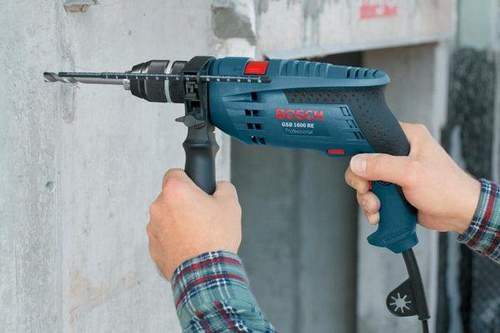What is the difference between a hammer drill and a hammerless drill?

For any construction and repair work, a manual power tool is used. perforators, conventional and impact drills. At first glance, this tool looks similar, but differs in functionality. You should be aware of the difference between a hammer drill and a hammer drill and a hammer drill, what is the difference between these power tools and how to choose them correctly.
The principle of the impact drill
Such a drill is designed to drill holes in metal, wood, plastic and durable materials. in brick and concrete. From the electric motor through the gearbox, the rotation is transmitted to the cam chuck, in which the cutting tool (drill) is fixed. To work with hard materials, brick and concrete, one rotation is not enough to make a hole.
It differs from a conventional drill by the presence of a ratchet mechanism, which gives the tool reciprocating movements. strokes, it is they that allow you to drill holes in a solid material.
Important! Conventional drills are not suitable for such work, it is necessary to use a tool with a winning tip.
The shock mode in such a power tool can be turned on and off. At idle, the percussion mechanism does not work, it only starts when the tool is pressed.
The main differences from the punch
These devices are primarily distinguished by functionality. The main function of the hammer drill is impact work, and rotation is just one of the functions. It can work in three modes at once:
Video: What is the difference between a hammer drill and a hammerless drill?
- Rotation.
- Rotation with shock work.
- Impact work without rotation.
Punchers use a pneumatic mechanism (like jackhammers) or electromagnetic coils. This explains the high power, you can not only punch holes in the walls, but also make strobes in brick and concrete for wiring, sockets and switches.
Hammer drill
The main disadvantage of the apparatus is the large mass, so work requires more physical strength than with an impact drill, which is lighter than it.
A significant difference between the punch is in the fastening of the working tool. Any electric drill has a cam chuck for the cylindrical shape of the tool, while in the punch the tool is attached due to special grooves. Therefore, you cannot use drills with a straight shank on a hammer drill.
Important! There is a special device. a cam cartridge, which is inserted into the hammer drill. Only with the help of such an adapter can you work on this tool with conventional drills.
Difference with a hammerless drill
An impact drill differs from a non-impact drill by the presence of a ratchet mechanism, which transmits a reciprocating movement to the working tool. This feature makes it possible to make holes even in brick and concrete.
A conventional drill is indispensable for delicate work when you need to drill a hole in thin or brittle materials. The soft stroke of the drill allows you to get high purity and accuracy of the processed surface.
Which is better to choose
There is no universal tool. For fast and high-quality work, it is necessary to choose the right power tool, starting from an impact drill and ending with a perforator. If drilling with infrequent impact work is necessary, we select the impact device. For large volumes of brick and concrete work, it is better to purchase a hammer drill.
The difference in power tools is not small. Of course, for the quality performance of the work it is advisable for the master to have all three types.
Useful articles, news and reviews on our Yandex Zen channel